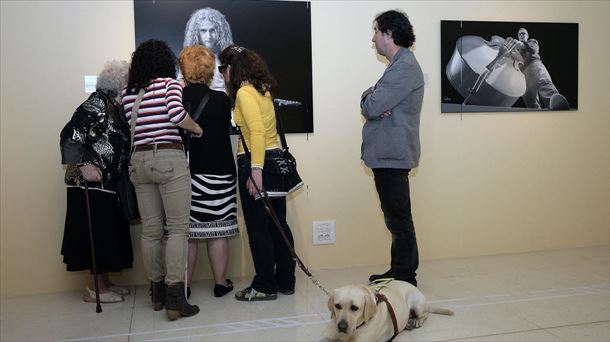Not only the fact of bringing art closer to blind people, but also bringing blind people closer to its production. “I’ve always been a restless person,” he says. the photographer Juan Torre (Getxo, 1956). Having worked as a graphic editor, Behcet’s syndrome caused him to lose his vision; him today he has a remaining vision of 6%. After coming and going with music and drums, Torre realized what “really felt” was the image: “It was my way of getting something out of myself.”
In the production of a book of his photographs, at Durer Studies, he came across a photo of the white moon with a black background. “I dared to touch the photo. It was a bit grotesque the fact of touching it, but I noticed that in the inks they used there was some relief”, recalls the photographer.
The moon led him to think about why they couldn’t touch the photos, and that his colleagues, friends could recover the pleasure of going to an exhibition “independently” and “to be able to touch, to be able to understand”. To those of Dürer it seemed “madness”, but Torre continued to insist on the idea, on the form, on the title: “Images to touch”. “In the end I managed to convince them and drag them into madness.”
Recovering his career in music and an image of drummer Sonny Emory, he based the exhibition on musicians for their “double meaning” as Torre explains: “Musicians who play and can be played.” In the photographs there is a “wink” between the world of music and blindness: Ainhoa Arteta with a mask, Mikel Erentxun with a handkerchief, El Drogas’ glasses… “Small details” that relate them.
“Testimonial”
“Images to touch” is a sample of inclusive art for the entire public. However, Torre emphasizes that “more needs to be done”. “Steps are being taken” in museums, as is the case with the reproductions of works at the Guggenheim, which premiered Jeff Koons’s “Tulips” model two weeks ago. The museum already has replicas of “Puppy”, “Mama”, “The Big Tree and the Eye” and the museum building.

Some visitors and Juan Torre in the exhibition ‘Images to touch’. Photo: Juan Torre
“We are reduced to a few very small spaces, it stays in something testimonial. There should be at least one testimony in the exhibitions that are made. A sample, a work of any discipline that could be played, that we be taken into accountTower argues.
There remains “a whole part of the culture” to address. In that task, the ONCE works hard so that the group of blind people and people with the rest of vision have access to any cultural offer. His impulse is to achieve “personal autonomy” of the group, according to Ana Dávila, head of the Department of Social Services for Affiliates of Euskadi.
In addition to museums, ONCE collaborates with and advises theatres, publishers, cinemas… They ensure that the content is suitable for blind audiences. Likewise, ONCE allocates a fund to subsidize cultural projects for its members. “In San Sebastián there are several singers with music groups; in Bilbao, a writer who has edited several books”, comments Dávila.
Torre stresses: “It’s not the same that they tell you about it as for you to participate and share with the rest of the people.” It is not a matter of blind people, it is a social issue.
Source: Eitb
Mario Twitchell is an accomplished author and journalist, known for his insightful and thought-provoking writing on a wide range of topics including general and opinion. He currently works as a writer at 247 news agency, where he has established himself as a respected voice in the industry.











